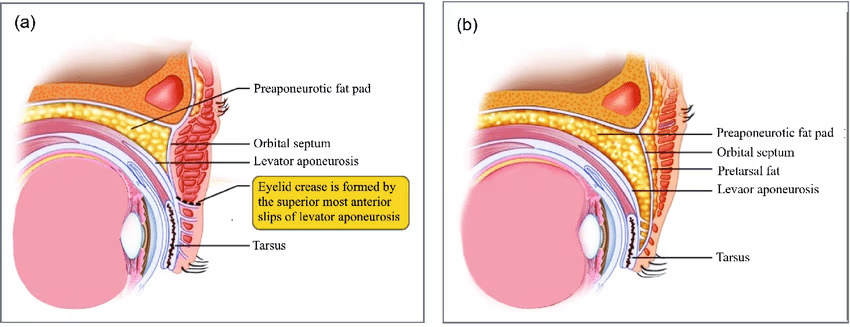Achieving natural-looking double eyelids in Singapore can significantly boost confidence and enhance facial features. If you’re considering this transformative procedure, there are several important factors to understand before making your decision.
As a comprehensive resource, this guide covers everything from non-surgical alternatives to surgical techniques, costs, recovery periods, and all your essential questions about double eyelid procedures in Singapore.
Why Do Some People Have Single Eyelids?
You might wonder why some individuals naturally have double eyelids while others have single eyelids.
The answer lies in anatomy:

A double eyelid forms when there’s a perfect connection between the eyelid skin and the deep eyelid opening muscle.
The crease appears where these two structures naturally attach. When individuals have naturally occurring double eyelids, it indicates that this connection is strong and well-defined.
For those with single eyelids (monolids), this natural attachment is either absent or not prominent enough to create a visible crease.
Non-Surgical Methods to Achieve Double Eyelids
If you’re hesitant about surgery, several non-surgical options can create temporary double eyelids:
1. Eyelid Tape or Glue
- Eyelid tape: Thin, clear strips placed on the eyelids to create a temporary crease.
- Eyelid glue: Uses the same principle but in a liquid adhesive form.
Both products help make eyes appear more alert and refreshed. Many users find that eyelid glue creates a more natural appearance compared to tape.
2. Plexr Blepharoplasty
This non-surgical procedure uses plasma technology to tighten the skin around your eyelid area, creating creases. The recovery time is relatively short (14-28 days), and results can last for the long-term.
Types of Double Eyelid Surgery in Singapore
There are two primary types of double eyelid surgery available in Singapore:
1. Non-Incisional Blepharoplasty (Suture Method)
This scarless technique involves stitching the eyelid to create a crease without making incisions.
Procedure details:
- Local anesthesia is administered before the procedure
- Four small holes are made to place the stitches
- The entire procedure typically lasts 20-30 minutes
- Minimal downtime since it’s less invasive than traditional surgery
Variations:
- Double Suture Technique (DST): Uses two twisted sutures to create a natural-looking fold
- Triple Suture Technique (TST): Employs three looped sutures that reinforce the fold, providing longer-lasting results and reducing chances of the suture loosening
2. Incisional Blepharoplasty
This technique involves cutting excess fat, skin, and muscle where the eyelid crease should be.
Procedure details:
- Can be performed under local anesthesia or sedation
- The surgeon makes an incision on the upper eyelid within the natural crease
- Excess fat and tissue are removed or repositioned
- The incision is closed with stitches or skin glue
- Recovery period is typically 2-3 weeks
- Results are relatively permanent
Additional benefits:
- Treats droopy upper eyelids
- Removes excess skin that may impede vision
- Can change the shape of the eyes for enhanced aesthetics
Cost of Double Eyelid Surgery in Singapore
The investment required for double eyelid surgery in Singapore varies based on the technique:
| Technique | Average Cost |
|---|---|
| Incisional Blepharoplasty | From S$5,000 |
| Non-Incisional (Suture) Method | S$3,200-S$4,000 |
The Double Eyelid Surgery Procedure
Before the Procedure
- Your surgeon will discuss anesthesia options (local anesthesia or sedation)
- Detailed measurements and markings will be made on your eyelids
- For non-incisional procedures, local anesthesia is typically recommended due to the shorter duration
During the Procedure
For Incisional Blepharoplasty:
- The surgeon makes an incision along the marked crease
- Excess fat, skin, and muscle are removed or repositioned
- The incision is closed with stitches or skin glue
- Stitches are typically removed after one week
For Non-Incisional Blepharoplasty:
- Four small holes are created to allow placement of stitches
- The procedure takes about 30 minutes for both eyes
- There’s minimal downtime as it’s less invasive
- Stitches can usually be removed after 4-5 days
Pain Management
Many patients worry about pain during the procedure. In reality:
- With sedation, you won’t feel or hear anything during the surgery
- With local anesthesia, you’ll remain awake and able to hear but won’t feel pain
- Post-procedure discomfort typically includes aching and tightened skin, which subsides as swelling decreases
Results and Longevity
The permanence of your double eyelid surgery results depends on the technique used:
- Incisional surgery: Results are permanent
- Non-incisional surgery: Results can last up to 10 years or more
It’s natural for your eyelids to change somewhat over time as your skin loses elasticity and eyelid muscles weaken with age.
Potential Complications and Surgery Failure
While double eyelid surgery is generally safe, there is always a possibility of complications or unsatisfactory results:
Common Reasons for Non-Incisional Surgery Failure:
- Poor technique: Inadequate training, using too few stitches, or outdated methods
- Unsuitable candidate selection: Patients with thick and heavy upper eyelids may not achieve optimal results
- Lack of scar tissue formation: Since no incision is made, there’s no area that can firmly attach the eyelid to the muscle
Post-Surgery Scarring
- Suture method: No visible scarring
- Incision method: Initial scarring will heal and blend with the skin within 4-6 months
Ensuring Optimal Results
To maximize your chances of successful double eyelid surgery:
1. Choose the Right Surgical Option
Discuss your desired outcome with your surgeon during consultation. Different eye conditions may necessitate specific techniques.
2. Ensure Precise Measurements
Accurate measurement of your eyelids is crucial for successful results. Proper discussion with your surgeon about expected outcomes helps minimize miscommunication.
3. Select an Experienced Surgeon
Highly trained surgeons with extensive experience are equipped to handle unexpected complications and are more likely to exceed your expectations.
4. Follow Proper Aftercare
Professional aftercare is essential following your procedure. Trained staff should guide you on:
- Pre and post-surgery protocols
- Recommended foods/supplements
- Managing side effects to minimize complications
Factors Affecting Your Double Eyelid Surgery Results
Several factors can influence the final appearance of your double eyelids:
- The natural size and shape of your eyes
- The amount of makeup you typically use
- Whether you wear contact lenses
- The initial shape and position of your eyebrows
Recovery Timeline
Non-Incisional Method
- Recovery is relatively quick
- Minimal scarring and swelling
- Return to normal activities within 2-10 days
Incisional Method
- Full results visible after approximately 6 weeks
- Scarring and swelling typically subside within a week
- Mild swelling or bruising may persist for several weeks
- Avoid bending or heavy lifting during recovery
Addressing Unsatisfactory Results
If you’re unhappy with your results, several options are available:
- Minor height and shape adjustments may be possible depending on your skin condition
- Corrective surgery can address major complications, though it carries additional risks
- Wait until all swelling subsides (especially for incisional methods) before pursuing corrections
Common Issues Requiring Surgical Correction
- Excessively wide or narrow fold: May occur when too much skin is folded or cut
- Sunken upper eyelid: Happens when excessive muscle is removed
- Uneven muscle removal: Requires release of adhesions and trimming excess fat
- Disappearance of double eyelid: Usually due to skin not firmly attaching to the tarsus
- Asymmetrical-looking double eyelid: Often results from imprecise measurements
- Loss of muscle strength: Can occur due to muscle injury
- Deformation due to infection: Requires new incision and release of scar adhesions
Optimizing Post-Surgical Results
For the best outcome:
- Use sunscreen and wear protective eyewear outdoors to prevent sun damage
- Avoid heavy exercise and lifting that increases eye pressure
- Apply cold compresses to reduce swelling
- Follow all aftercare instructions from your surgeon
Finding the Best Double Eyelid Surgeon in Singapore
To locate a qualified surgeon:
1. Research Thoroughly
Gather information online and ask for recommendations to find reputable clinics. Review before-and-after images to assess which aesthetic results align with your preferences.
2. Choose a Surgeon Who Prioritizes Your Goals
Look for a surgeon who takes time to measure your eyes precisely and discuss various crease shapes and heights to help you achieve your desired outcome.
Korean-Style Double Eyelid Surgery
Singapore has several specialists trained in Korean double eyelid techniques, which are known for creating natural-looking results. Some clinics offer specialized approaches:
Triple Suture Technique
This advanced method uses three looped sutures that strengthen the fold, reducing the chance of sutures loosening over time. The technique creates longer-lasting results and is especially suitable for patients with complex eyelid structures.
Benefits of Korean-Style Techniques:
- No incisions or cutting, resulting in no scarring
- Emphasis on creating an elongated, natural-looking crease
- Faster healing process
- Reversible if desired
Which Technique Is Right for You?
Suture Method is Recommended for:
- Eyelids with several creases
- Monolids (eyelids without existing creases)
- Asymmetrical eyelids (double eyelid on one eye only)
- Faint eyelid creases
- Thin, sagging eyelids
Incision Method is Recommended for:
- Thick or saggy eyelids requiring removal of excess fat and tissue
- Those wanting permanent results
- Patients desiring a deeper, well-defined crease
- Revision surgery cases
Frequently Asked Questions
Is double eyelid surgery painful?
The procedure itself is not painful due to anesthesia. Post-procedure discomfort typically includes aching and tightened skin, which subsides as swelling decreases.
Why do many people want double eyelids?
Single eyelids can make eyes appear smaller and less prominent. Double eyelids create a more open, bright look that softens facial features. As we age, skin laxity and puffiness become more noticeable, which double eyelid procedures can address.
What does “crease height” mean?
Crease height indicates whether the eyelid fold is positioned higher or lower. Measurements are taken where the eyelash margin meets the eyelid margin with the eyes closed. The ideal crease height depends on eye size and eyebrow position.
How do surgeons determine whether to use non-incisional or incisional techniques?
Patients with excess skin and fat, puffy eyelids, or ptosis (drooping eyelids) typically benefit from incisional surgery, where excess tissue is removed. Those without loose skin are better candidates for non-incisional techniques. Your surgeon will make recommendations based on your consultation.
How permanent are the results?
Incisional procedures provide permanent results. Non-incisional techniques typically last 10+ years.
Are there risks of surgery failure?
Any surgery carries some risk of failure. This usually happens with poor techniques or inaccurate measurements. With a well-trained, experienced surgeon, the risk is minimal.
What non-surgical alternatives exist?
Double eyelid tape and glue can create temporary creases but require daily application. These may cause skin irritation with long-term use. For a more lasting non-surgical option, consider Plexr blepharoplasty or consult about Korean-style double eyelid creation.
Conclusion
Double eyelid surgery can provide long-lasting, natural-looking results that enhance your appearance and confidence. Whether you choose a non-incisional or incisional approach, understanding all aspects of the procedure is essential for making an informed decision.
Before proceeding, ensure you’re well-informed about both the benefits and potential side effects. Consult with a trusted, experienced surgeon who can guide you toward the best option for your specific needs and aesthetic goals.

